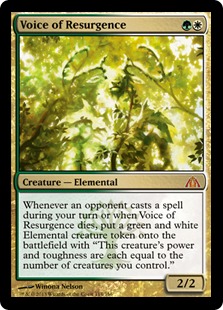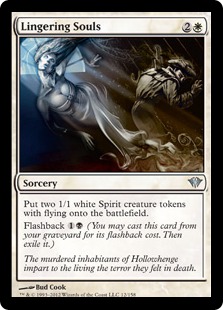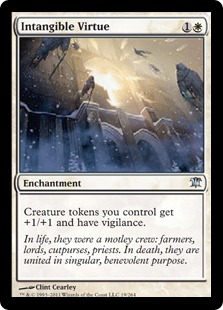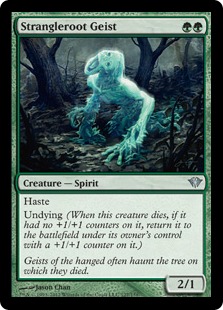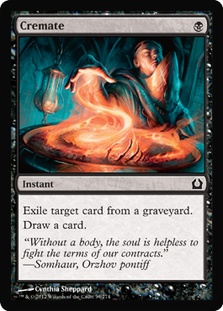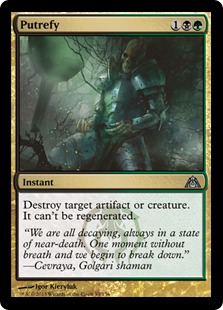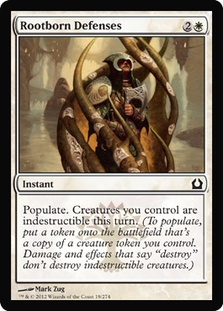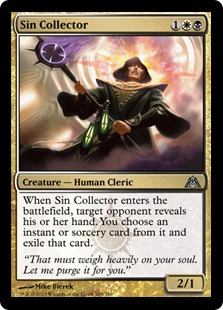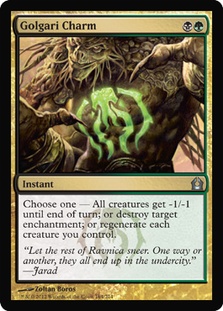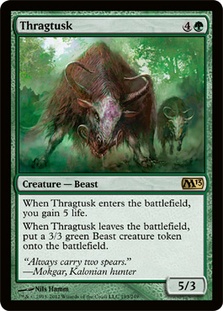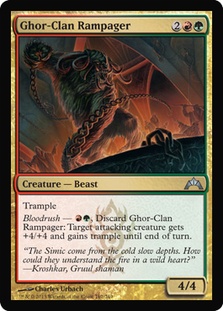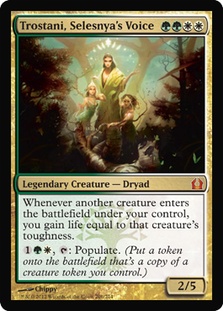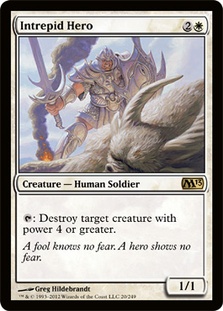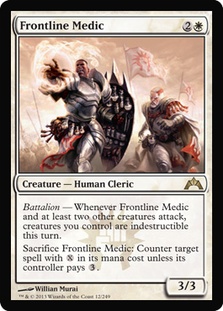In today’s article, I’m going to discuss the new version of the Junk Tokens deck that I have been tuning for Standard. I have been playing and tuning the deck for two weeks now and believe that it is a very strong option for tournament play.
Last week, the retooled version of the deck had a combined record of 12-2-1 in tournament play, which is a very solid result for any deck to put up.
I stumbled upon the archetype when one of the local players, Brenda Smith, came to my R.I.W. playtesting night with the proto-version of the deck and crushed most of the decks in the room. The first week I made a few slight adjustments to her list and played the deck to a 4-1 (Top 8 split) record in a 50-player Standard event.
Even after getting a pretty good result, I thought that the deck could be made much better. Brenda played the revised version of the deck in a 5K tournament over the weekend and felt that it still struggled with its mana and had a tough time beating red-based aggro. So last week I rebuilt the deck, and the results really speak for themselves. I gave the deck to Mark Biller, and he made Top 8 of a 65-player event.
Without further ado, here is the revised list:
Creatures (15)
Lands (23)
Spells (22)
- 2 Putrefy
- 4 Intangible Virtue
- 4 Lingering Souls
- 2 Rootborn Defenses
- 2 Call of the Conclave
- 4 Selesnya Charm
- 4 Advent of the Wurm
Sideboard

The biggest change to the deck from the last time I talked about it is that it now has four Avacyn’s Pilgrims; three Strangleroot Geists; and four Loxodon Smiters in place of two Sorin, Lord of Innistrads; two Garruk, Primal Hunters; three Scion of Vitu-Ghazis; one Armada Wurm; two Vault of the Archangels; and one Call of the Conclave.
The basic idea behind this deck remains the same:
Voice of Resurgence is the best card in Standard right now by a mile, and this is a deck that really pushes it to the maximum value.
"I said that this guy was going to be the best card in Standard before the set came out and suggested that people preorder their playsets at $20."
One of my favorite plays with this deck is trading with my Voice of Resurgence during my opponent’s turn. Maybe they Supreme Verdict it away or a red deck kills it in combat somehow.
I can untap, play Lingering Souls, flash it back, and attack for five with the Elemental token! This is what I mean by getting maximum value out of Voice of Resurgence. In this deck, those tokens (if they live) get really out of hand really quickly.
The changes all provide the deck with much better starts than was possible before, especially considering that the deck now has a very good one-drop play that sets up powerful second turns like Loxodon Smiter and Lingering Souls.
The deck also has a very powerful nut draw that is difficult for most decks to beat when they are on the draw.
"It’s good to have a nut draw."
Turn 1: Avacyn’s Pilgrim.
Turn 2: Lingering Souls.
Turn 3: Intangible Virtue (attack for four) and Flashback Lingering Souls.
Even against a deck that threatens to cast Supreme Verdict on turn 4, this particular draw can attack for seventeen on the play while leaving up mana for Rootborn Defenses, a lethal Selesnya Charm Knight token, or Advent of the Wurm after they try to clear the board. The fact that this deck has a nut draw makes me really happy, as it is a relief to get free wins from powerful draws.
The other big innovation that I made while tuning the deck against various aggro decks is that there is no reason to be reined in too hard by the idea of being a token theme deck.
"Super happy fun time with the beatdown buddies."
Strangleroot Geist and Loxodon Smiter are both really aggressively costed creatures that are fantastic in the combat zone, which is exactly what this deck needed to get better.
The fact that the sideboard is well put together is another factor that helps to make this deck a strong choice.
Vs. Junk Reanimator
In
"Tearing up your yard."
Out
"Just get after them."
I board out all of my Intangible Virtues and Rootborn Defenses and some number of Lingering Souls depending on how much hate I decide to bring in.
One important thing I quickly recognized is that it is really difficult and counterproductive to try to cast Rest in Peace because it does a lot of splash damage to our deck. It makes our Voice of Resurgences, Lingering Souls, and Strangleroot Geists less effective.
Instead, I opted for Deathrite Shaman because it really helps with my proactive plan of attacking Junk Reanimator to death as quickly as possible while at the same time protecting me from their Angel of Serenity recursion.
Cremate also lets me "surprise, you’re dead!" blow them out if they try to go for a quick Unburial Rites while they are under pressure.
I’m not actually sure if the Acidic Slimes are good against this deck, but the token deck’s fast draws with Geist or Smiter really punish them for trying to be so greedy with expensive spells.
Vs. Sphinx’s Revelation Decks
Out
"Goodbye do-nothings."
In
"Hello blowouts."
Basically, these decks tend to have a lot of removal and card draw, so it is important not to draw blanks after our first wave of creatures die.
Against decks without creatures, I would board in Golgari Charm to counter Supreme Verdict and destroy Detention Sphere. Against Bant decks that are unlikely to play very many Supreme Verdicts, I bring in more Putrefys to get their Wurm tokens.
Vs. Bant Hexproof
Out
"Champions are crowed by good defenses? Not in this matchup."
In
"Champions are crowned by destroying Auras."
This is pretty straightforward; if you kill their Unflinching Courage in combat, they cannot possibly win the game. I suggest doing that as often as possible.
Vs. Red Aggro Variants
Out
"Comes out in every matchup except G/W mirrors."
In
How you sideboard will depend on which cards you anticipate them playing in their deck and out of their sideboard.
If they are Thundermaw Hellkiting, then obviously Lingering Souls is a liability. If they have Stromkirk Noble, Arbor Elf, Legion Loyalist, and a bunch of one-toughness guys, then our Golgari Charms become much better than just "regenerate the team," which to be fair is pretty solid in a matchup that is all about combat.
One trick that is really important to know about this matchup is this exact scenario that I have seen people mess up about fifteen times while playing the deck.
You play a Loxodon Smiter onto a board where they have a Burning-Tree Emissary and a Flinthoof Boar. They untap and attack with their two guys into your Smiter, and you have a Selesnya Charm in your hand. Please, for the sake of my sanity, don’t block the Flinthoof Boar and get blown out by the Ghor-Clan Rampager that they for sure have.
It is so much better to blow them out with the Selesnya Charm or flash down Advent of the Wurm or anything than to lose the game on the spot to their Rampager.
Obviously, if you are super far behind and you have no choice but to block to not lose, then do it. However, think about it from their perspective. If you have a high life total, are they really going to trade their Flinthoof Boar for +2 damage? Would they trade their Boar + a Searing Spear for +2 damage? If the attack only makes sense if they have a Rampager, play as though they have a Rampager!!!
"Rule of thumb: if their attack only makes sense if they have a Rampager, then you should assume they have a Rampager and play accordingly!"
Other Possibilities for the Sideboard and Maindeck
"The other Selesnya Voice."
This card can clearly take over games and win them on its own. The problem is that it takes four mana to play and is sorcery speed. It is also quite difficult to cast at times, as I can’t guarantee the deck will produce WWGG on turn 4 every game if Avacyn’s Pilgrim gets burned or Tragic Slipped away.
The board plan of populate can eventually get trumped by a Bonfire of the Damned, which makes me want to attack more proactively rather than durdle making tokens.
I have played with the card in my sideboard, but it hasn’t been nearly as good as I want it and expected it to be. Every time I drew Trostani, I wished it were a Putrefy, and every time I sideboarded against Jund, I wished I had another Putrefy.
Guess what? I cut it for Putrefy!
"Surprise! David beats Goliath again! And again! And again!"
This card is an absolute all-star in G/W mirror matches because it allows you to kill every Elemental token and Wurm token on sight. The problem is that I don’t really like it in any matchup outside of G/W. However, there are very few cards that I fear more than this white weenie.
"The Doctor is out (for now)…"
I like that this card provides some degree of protection from Bonfire of the Damned and Sphinx’s Revelation while also allowing us to attack with impunity into opposing boards.
It may very well earn a spot in the deck before my time playing it is through. It would certainly be a nice trade out for Lingering Souls (especially in the curve) for matchups where I want to take Souls out (aka Thundermaw Hellkite decks).
Final Thoughts
One thing you might have noticed about the deck is that I board out Lingering Souls and Intangible Virtues in almost every single matchup. If that is the case, why even bother playing them at all?
Well, there is a good theory behind that decision. The reason is that in almost every matchup the combo is very solid and provides my deck with powerful plays in the abstract. Lingering Souls is a powerful Magic card, as is Intangible Virtue, and they both make the other even more powerful in combination.
However, after sideboard a player can hone in their strategy to be better against whatever the opponent is actually doing:
Sin Collector vs. Control
Ray of Revelation vs. Auras
Deathrite Shaman vs. Reanimator
It is because the deck has powerful hate cards aplenty to bring in that we no longer need to have a generally good card in the maindeck—especially one that our opponents may be aiming to hate out with sideboard cards like Naturalize, Thundermaw Hellkite, and Illness in the Ranks.
I remember back in the day that a bunch of decks played maindeck Vindicate and boarded it out for something more matchup specific after sideboard. Vindicate was always useful and quite good, much in the same way that Intangible Virtue + Lingering Souls is, but it comes out specifically because there are better things to be doing out of the board.
Anyway, I hope that some of you readers take this deck for a test drive. I have been playing it for two weeks straight now and have been really pleased with the results I have gotten with it.
It is also super fun to play, as there are many powerful instants and interactions that allow its pilot to force the action of the game.
Not to mention that Voice of Resurgence is literally the best card in Standard right now by a wide, wide margin and this is one of the better Voice of Resurgence decks that I have seen or played.
Cheers,

